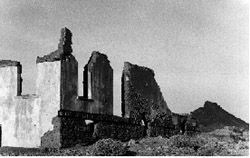Swansea, Arizona facts for kids
Quick facts for kids
Swansea, Arizona
|
|
|---|---|

Remnants of Swansea.
|
|
| Country | United States |
| State | Arizona |
| County | La Paz |
| Founded | 1908 |
| Elevation | 1,283 ft (391 m) |
| Population
(2009)
|
|
| • Total | 0 |
| Time zone | UTC-7 (MST (no DST)) |
| Post Office opened | March 25, 1909 |
| Post Office closed | June 28, 1924 |
Swansea is a ghost town located in La Paz County, Arizona. It was founded around 1909 as a busy mining town. People came here to mine copper and process the metal from the nearby mines.
Contents
History of Swansea
Mining for copper in this area started way back in 1862. But because the location was so far away and hard to reach, not much mining happened at first.
Building a Mining Town
By 1904, a railroad was being built near Parker. Two local miners, Newton Evans and Thomas Jefferson Carrigan, saw a great chance to develop the area. They worked hard and, in just a few years, built a large furnace to process ore. They also built a water pipeline from the Bill Williams River and hoists for five mine shafts.
They first named their new town Signal. This is not the same as another Arizona ghost town called Signal. By 1908, a company called Clara Gold and Copper Mining Company took over the mining claims. They set up their main office in the mining camp that would soon become Swansea.
That same year, a railroad called the Arizona and Swansea Railroad connected Signal to Bouse, about 25 miles (40 km) away. These new developments helped the town grow quickly. Its population soon reached about 300 people.
How Swansea Got Its Name
When mining first began, there were no facilities in Arizona to process the copper ore. So, the ore had to be sent far away for smelting (melting metal to remove impurities). Most of the ore went to a town called Swansea, in South Wales, United Kingdom. It traveled by train to the Colorado River, then by ship from the Gulf of California all the way around Cape Horn to the United Kingdom.
In 1909, a smelter was finally built in Arizona. The town of Signal then changed its name to Swansea, honoring the place where their ore used to be processed. The post office opened on March 25, 1909, also under the name of Swansea.
At its busiest, Swansea was a lively town. It had an electric company, a car dealer, a lumber company, and even two cemeteries. There was a saloon, theaters, restaurants, barbershops, an insurance agent, and a doctor. Of course, the main attractions were the mining and smelting facilities.
Why Swansea Became a Ghost Town
Swansea's busy life didn't last long. By 1911, the Clara Consolidated Gold and Copper Mining Company was having money problems. The company's manager, George Mitchell, spent a lot of money on fancy improvements to attract investors. But he didn't focus enough on making the mining process itself more efficient.
Because of the high costs of improvements and production, the mines couldn't make a profit. It cost more to produce copper than they could sell it for. The company went out of business in 1912, and the mines closed down.
After a brief attempt to restart mining later that year, the mines and the town stayed quiet. Then, in 1914, the American Smelting and Refining Company bought the properties. They reopened the mines and helped the town grow again.
Swansea continued to thrive until just after World War I. At that time, copper prices dropped sharply. This caused the town to decline quickly. Swansea's post office closed on June 28, 1924, and most people left. By 1937, the mines shut down completely, and Swansea officially became a ghost town.
What's Left of Swansea Today?
Today, Swansea is protected by the Bureau of Land Management. It's called the Swansea Town Site Special Management Area. Over time, weather and vandalism have damaged the old buildings.
However, visitors can still see many adobe structures (buildings made of sun-dried mud bricks). You can also find the remains of the old railroad depot, two cemeteries, and several mine shafts. Many old car parts are scattered around the site.
The Bureau of Land Management has worked to preserve Swansea. They have put new roofs on rows of small houses where miners used to live. They also created a walking trail for visitors to explore the site. They are working to strengthen other old structures as well. You can also see many stone foundations where buildings once stood.
Where is Swansea Located?
Swansea is about 25 miles (40 km) northeast of both Bouse and the town of Parker. It is located at 34°10′12″N 113°50′46″W / 34.17000°N 113.84611°W. The site is in a remote area, and you can only reach it by driving on rough, gravel roads.
How Many People Lived in Swansea?
According to the US Census, 400 people lived in Swansea in 1910, shortly after it was founded. In 1920, just before it was abandoned, the population was 337. Some reports suggest the town's population might have reached about 750 people at its peak. However, because the town grew and declined so quickly, it's hard to confirm that exact number.
Swansea in Popular Culture
- In the Chris Ryan novel, Blackout, Swansea is where the character Luke hides out.
- The training scenes for the 1971 movie The Day of the Wolves were filmed in Swansea.
- Folk singer Joanna Newsom included a song about Swansea on her 2004 album The Milk-Eyed Mender.




